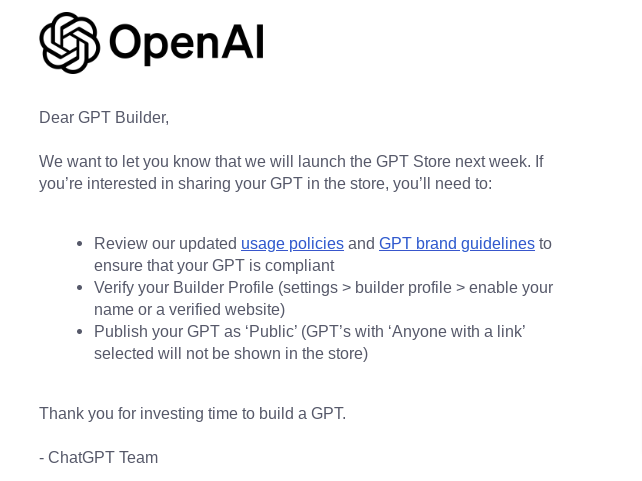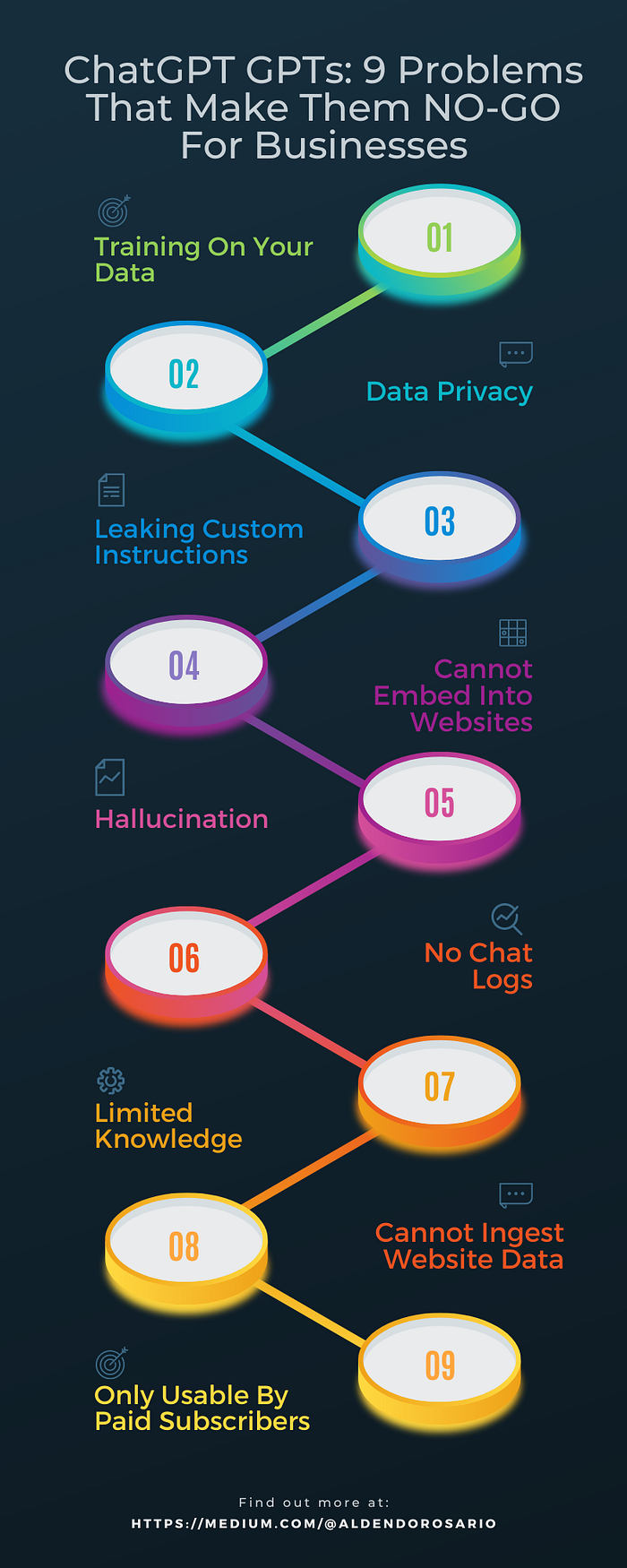
OpenAI GPTs: 9 Problems That Make Them NO-GO For Businesses
Last Updated on January 10, 2024 by Editorial Team
Author(s): Alden Do Rosario
Originally published on Towards AI.
With the recent announcement from OpenAI about building your own GPTs, anyone with a $20 ChatGPT Plus subscription can now create their own GPTs.
Everyone is rushing in to create their own personal GPT, from YogaGPT to PeterGPT to SEO-GPT.
Consumers and individual creators are rushing in to create customized GPTs tailored to whatever special niche they are in.
In fact, OpenAI just announced that they will launch a GPT Store next week.

This release from OpenAI really demonstrates the power of their latest technology and includes tools like uploading your own knowledge, the ability to dynamically calculate and run code, and the ability to dynamically generate images in the response.
These are excellent multimodal tools that will greatly help in creating interest in personalized GPTs, just like the initial launch of ChatGPT set off a consumer wave exactly 1 year ago
For most consumers, these tools, at a very affordable price of $20/month, let you create a personal media presence, just like creating your website 25 years ago or creating your own YouTube channel a few years ago.
Unfortunately, when it comes to business use, this consumer option is lacking some key requirements that every business needs.
And so, in this blog post, I will be covering some problems that make these GPTs a “No Go” showstopper for real businesses.
Until now, very, very few businesses have actually jumped on the bandwagon for these consumer GPTs.
And in this blog post, you will see why.

Problem 1: Training On Your Data.
The biggest problem with the GPTs is that anything you or your users upload to the GPT can then be used by ChatGPT for its training.
This means that in a few months (or weeks), it could become part of ChatGPT’s own knowledge base, and then anyone can prompt and query it.
This is an immediate showstopper for most businesses with confidential IP. The knowledge and expertise that you have gathered over many years is your secret sauce and cannot be made public.
Problem 2: Data Privacy
The second biggest problem is: The raw files you upload can be easily downloaded and captured by competitors.
Just imagine your competitors going and recovering the knowledge in your raw files. Notice the big disclaimer there:
If you upload files under Knowledge, conversations with your GPT may include file contents. Files can be downloaded when Code Interpreter is enabled.
Just to reiterate: “Files can be downloaded” ..
Problem 3: Leaking Custom Instructions
You spent all that time coming up with excellent “custom instructions” that control how the GPT behaves — probably with lots of testing.
The bad news: The “custom instructions” can be easily leaked to competitors or other creators looking to replicate or improve on your GPT.
It’s almost scary how easy it is to do ..
Problem 4: Cannot Embed Into Websites
This is another big showstopper showing up on social media. What is the value of creating a personalized GPT if you cannot embed it on your website?
Currently, you have to share a link to your GPT and then send your visitors to chat.openai.com to use it.
Even worse, your users will need to have the $20 ChatGPT Plus subscription to access your GPT, which is a bad experience if you are a business.
The ideal scenario would be to be able to create a GPT for your business and then embed it into your website or your customer experience so that your customers seamlessly get the benefit of it.
Maybe you even want to charge your customers for this added benefit or use it as a hook for lead generation.
This requirement to offload your users from your website to chat open.com severely hampers your customer experience and might even result in increases in bounce rates.
Problem 5: Hallucination
The GPTs have no in-built anti-hallucination. They are designed to be creative, which means that — as a business — if a user asks about your competitors or asks something about your business, the GPT will happily make up facts about your business.
There needs to be built-in anti-hallucinations, which is clearly lacking in these personalized GPTs.
Not just that, but as a business, you need to have clear trust and accountability around where the responses are coming from via sources and citations. This is clearly lacking in the GPTs, which makes it a potential brand or legal liability.
Problem 6: No Chat Logs.
This scares any real business. An AI is making up AI responses about your business and you have no idea what the user is asking or what the AI is responding with.
Meaning that you have no clear way to audit the usage or manage the risk associated with the GPT.
Since you are building the GPT for free (pretty much!) and it is being used by ChatGPT customers, OpenAI is under no obligation to show you the chat logs and how the GPT is being used.
This means that you are totally blind to the GPT’s usage and cannot even understand or improve it over time.
Even more importantly, the whole point of creating GPTs like this is to understand customers’ behavior and query patterns.
The chat logs and query patterns associated with the users are a goldmine of information.
These chat logs should be able to tell you how users feel about your business and what they need from it. By hiding the chat logs, OpenAI is not doing you any favors.
It becomes a black box and a high risk for your business.
Problem No 7: Very Limited Knowledge.
Currently, you can only upload 20 files to the knowledgebase. This is extremely limited for most businesses.
Most businesses have vast amounts of knowledge as represented by their website, helpdesks, product manuals, PDFs, YouTube videos, and audio.
There is also a limit of 1.5M words, which is severely limiting when it comes to business use.
And if your business has any advanced requirements, like being able to incorporate scanned images or other advanced document formats like ePub, then you are out of luck.
Problem No. 8: Cannot Ingest Website Data
Possibly, the biggest issue with data ingestion is that these GPTs cannot easily ingest website data and make it part of their knowledge base.
For example: Even though you have that beautiful WordPress website with all your business information and blog posts, it is virtually impossible to make it part of your GPT knowledge base.
If a tool like this is unable to ingest website data, it severely limits what can be done with this individualized GPT. What most businesses want is to create a GPT, which is the “source of truth” of information about your company — especially the publicly-available information.
A GPT that truly answers every question associated with your company.
Problem No. 9: Only Accessible To Paid Subscribers
The beauty of creating a GPT is that you should be able to deploy it and make it work for your business.
You should be able to deploy it for Live Chat customer service for your website visitors.
Or take over after-hours from your customer support team (Hint: This is a hot emerging use case!) — where the AI takes over after the employees have left for the day.
You want to share your GPT with your customers, so that they don’t have to read through 200-page PDFs.
You want to embed it into your intranet for employees.
Most importantly, you also want to integrate it with other systems like Slack or Facebook Messenger or WhatsApp or SMS.
Without these deployment options, the GPT cannot be truly put to work — and have an effect on your business.
Or help you make money. (more on this in a later post!)
For businesses, it’s not about showing off, it’s about using the tool to drive actual ROI and employee productivity.
Businesses want their employees to be more productive via the use of this AI.
Combining Sentiment Analysis with Retrieval Augmented Generation (RAG)
One of the most amazing things about Generative AI is: You can now get AI to do things for you — just by changing a few…
medium.com
Or drive revenue via lead generation and workflows.
You should be able to do these things without writing a single line of code. And the lack of deployment options hinders the business use of the GPTs.
What’s Next?
These are just some of the major items I noticed with the release of the new GPTs. Now, just to be clear, it’s technically possible that OpenAI — given its speed of innovation — could fix a lot of these problems.
It is unclear how many of these problems would actually be resolved.
Please note: This blog post is about the OpenAI GPT builder, which is the no-code UI dashboard that you see in ChatGPT Plus. If you are a Ninja developer, you can always use Assistants API and technically solve all of the above problems.
However, these problems need to be solved so that businesses can deploy generative AI and make an actual impact on their ROI without having to kick off expensive development projects and infrastructure management.
And until OpenAI fixes these issues, others will.
Join thousands of data leaders on the AI newsletter. Join over 80,000 subscribers and keep up to date with the latest developments in AI. From research to projects and ideas. If you are building an AI startup, an AI-related product, or a service, we invite you to consider becoming a sponsor.
Published via Towards AI
Take our 90+ lesson From Beginner to Advanced LLM Developer Certification: From choosing a project to deploying a working product this is the most comprehensive and practical LLM course out there!
Towards AI has published Building LLMs for Production—our 470+ page guide to mastering LLMs with practical projects and expert insights!

Discover Your Dream AI Career at Towards AI Jobs
Towards AI has built a jobs board tailored specifically to Machine Learning and Data Science Jobs and Skills. Our software searches for live AI jobs each hour, labels and categorises them and makes them easily searchable. Explore over 40,000 live jobs today with Towards AI Jobs!
Note: Content contains the views of the contributing authors and not Towards AI.















